SUN AN’ SOUL - DREAM AN’ ROME
VATICAN MUSEUMS - RAPHAEL STANZE
It was the legendary 1508, when Michelangelo began to fresco the ceiling of the Sistine Chapel and shortly after Raphael The Vatican Stanze for Pope Julius II Della Rovere, who could not stand to live in the apartments of the hated Pope Borgia, as frescoed by Pinturicchio, he wanted his apartment had nothing to envy to that of Alexander VI, by the way he set to work the best painters of the time: Perugino, Baldassare Peruzzi, Lorenzo Lotto, Sodoma,
and Raphael.
Raphael began from the vault of the Stanza of the Segnatura, which is so named because it was destined for the highest court of the church: the “Signatura Gratiae et Iustitiae”.
And here Julius II showed his good character: seeing the first fresco by Raphael, he dismissed all the other painters and ordered to destroy the frescoes painted before. But Raphael, showed his own character: he called Sodoma and Baldassare Peruzzi and saved the frescoes by Perugino, his old master painted in the Stanza later named “Fire-Stanza”.
Then Raphael entered triumphantly in the papal court of Rome which Vasari said was "the common country always helpful to the best talents".
In the papal court, at that time, had flocked the best talents of the Renaissance and among the prelates could be found humanists of the highest culture, fascinated by neo Platonism, with its categories of the True, the Beauty and the Good. Represented in the vault with theology or the theological True; philosophy: the philosophical True; poetry: the Beauty and Justice: the Good.
The first wall to be painted in 1509 is known as the Dispute of the Sacrament ie discussion among theologians. A witness to the Raphael's commitment were found 40 preparatory drawings of the Dispute.
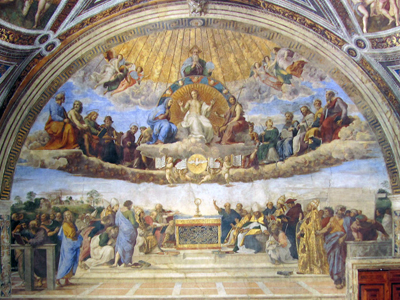 |
| Raphael Stanze, Dispute of the Sacrament - click to enlarge |
The fresco is divided into two registers, the upper register shows the Church triumphant, the lower register the Church militant. In the church triumphant one sees the Trinity with Jesus at the center, under Him the angels show the Holy Scriptures. To his sides saints and prophets.
The characters of the church militant suggested to Giorgio Vasari to call dispute, ie discussion, the fresco. Discussion that occurs in transport by which the characters face the mystery of the Eucharist.
To the left of the altar we see: leaning on the balustrade, the great architect Donato Bramante, the character close to him has been identified as the eighteen year old Francesco Maria Della Rovere, nephew of Pope Julius II, just became Duke of Urbino, follows Julius II, in the guise of St. Jerome, standing next to a lion and finally the Beato Angelico with his Dominican habit.
To the right: Sant'Ambrogio, looking upwards, St. Augustine in the act of dictating, behind St. Thomas Aquinas, then Pope Innocent III, famous theologian, Saint Bonaventure, another great philosopher and theologian, Pope Sixtus IV Della Rovere, Julius II's uncle, to follow the unforgettable portrait of Dante and hidden, with a dark hood, Savonarola.
The vivid and immediate participation of the characters gives a concrete idea of the church militant, and was triumphantly welcomed in the papal court, so that Vasari records "may not any painter conceive thing more graceful nor more perfect".
Let now see “The School of Athens”, painted from 1509 to 1510, the composition of great complexity, behind which one imagines that the best humanists of the papal court have dispensed their advice to Raphael.
 |
| Raphael Stanze, The School of Athens - click to enlarge |
As for the prospects, certainly inspired by Donato Bramante, it was thought, to a suggestion of the same Bramante or more likely of Bastiano da Sangallo. The position occupied by each character has a meaning, without stiffening the scene, in the words of Vasari: "Raphael was in the composition of the stories so easy and ready that rivaled the effectiveness of the written word". It is thought to have been assisted by Sodoma, who appears together with Raphael in the far right.
The concerted nature of the representation is focused on Plato and Aristotle. Plato with his left hand holds the Timaeus, the fundamental dialogue that addresses the issues of the origin of the universe, of the structure of matter and the nature of man. The right hand is pointing at the sky, at his side Aristotle holding the Ethics, where distancing himself from his teacher Plato, seeks the truth in reality, to arrive at conclusions often far from common perceptions. And if Plato points to the sky, Aristotle has the right hand stretched forward. The two different gestures seem to suggest the need for synthesis between the Platonic transcendence and the immanence of Aristotle.
However, all the other characters in their choral represent the evolution of thought, not at all see them alongside the protagonists, or along the staircase.
A large part of figures Raphael gave the face of men of his time, Plato is none other than Leonardo da Vinci, Aristotle is Bastiano da Sangallo, who from then on was called precisely Aristotle.
Among the many characters in the bottom center, leaning on a block of marble, stands out Michelangelo alias Heraclitus.
The portrait by Michelangelo, added by Raphael when the fresco had already been completed, shows his nature, fact once discovered the first part of the ceiling of the Sistine chapel, to pay homage placed him in the foreground.
Completed the philosophical True, following the neo-Platonic categories, Raphael in the second half of 1510 painted the Parnassus, that is the Beauty in the wall that overlooks the courtyard of the Belvedere, where Julius II had collected, saving them from the dispersion, "I Marmi Antichi" (=ancient marbles), including the Group of the Laocoon and the Apollo, precisely named, Belvedere Apollo.
Raphael was so impressed that gave to Homer the face of Laocoon, putting alongside Apollo, with its nine Muses, as if to say that the beauty god had moved from Parnassus, to take home in the Vatican.
Apollo and his muses divides poets into two groups, on the left next to Homer we see
Dante and Virgil, while a sitting Ennio is listening to Homer. Below from left to right: Alcaeus, Corinna, Petrarca, Anacreon and Sappho. In truth the only positive identification is to Sappho, as the sheet of paper she's holding has his name. Note the concerted nature of the scene, the expressiveness of the faces and the beautiful color scheme.
Passing on the right identifications are even more dubious, the only generally accepted is that of Horace sat down.
The last wall to be painted represents the Justice.
 |
| Raphael Stanze, The Justice - click to enlarge |
In the lunette we see the other three cardinal virtues: Fortitude, which is recognized by the helmet, Prudence and Temperance with the reins in his hand. The two frescoes separated from the window, designed by Raphael were painted, probably by Sodoma, that in which Justinian delivery Treboniano the famous Pandette, that is, the civil law and by Baldassare Peruzzi Gregory IX, with the face of Julius II, who receives from Raymond of Penafort the Decretals, that is the canonixcal law.
In this fresco we see even four Popes, given that at the right of Julius II is Giovanni de' Medici, his successor under the name of Leo X and to his left Alessandro Farnese, who became pope under the name of Paul III, while behind Giovanni de' Medici is the cousin Giulio de' Medici, later Pope Clement VII.
Julius II increasingly enthusiastic about Raphael gave him no respite, and as soon as the Stanza of the Segnatura was completed , already in 1511 Raphael started the Heliodorus Stanza. For the historical events of the time, Raphael was called to represent the theme of the invincibility of the Church thanks to divine protection.
The first wall to be painted was the Expulsion of Heliodorus from the Temple.
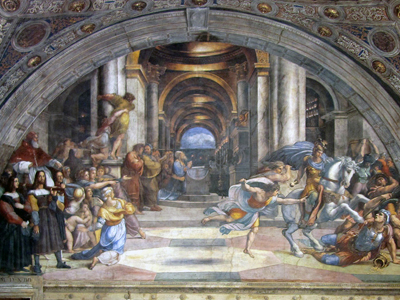 |
| Raphael Stanze, Expulsion of Heliodorus from the Temple - click to enlarge |
The episode sees at the center of the fresco the high Judean priest Onias, while invoking God's help to oust Heliodorus from the Temple in Jerusalem he wanted to profane. And God's help comes thanks to a knight who strikes Eliodoro and his followers. In the scene, once again appears Julius II.
Beyond the clear metaphor, represented by divine intervention, which is the theme of the Stanza, of exceptional cultural and historical interest, testimony to the freedom of the Renaissance feel, is the simultaneous presence of the Pope and of the High Priest Onias, to represent the uniqueness of the God of the Christians and Jews.
Completed in 1512, the expulsion of Heliodorus, Raphael began the Mass of Bolsena, reminiscent of a miraculous event following which was instituted the feast of Corpus Christi and built the cathedral of Orvieto.
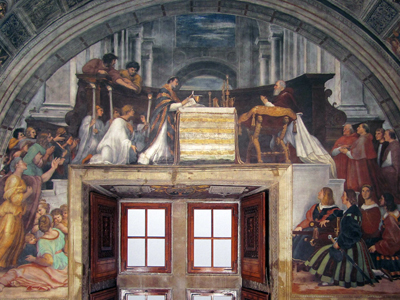 |
| Raphael Stanze, Mass of Bolsena - click to enlarge |
Memorable for realism, liveliness and for the ability to interpret the characters, are the portraits of the prelates on the right, belonging to the papal court and well known to Raphael. With his hands crossed on his chest is portrayed Raffaele Riario, standing next to Leonardo Grosso della Rovere, followed by Agostino Spinola and Tommaso Riario.
All these personages were related to Julius II.
We thus come to 1513 when Raphael began the Liberation of St. Peter.
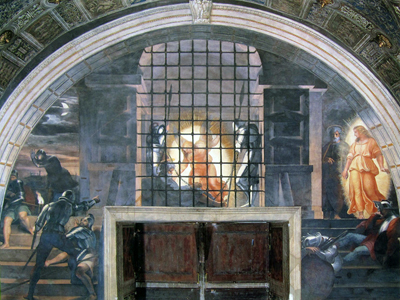 |
| Raphael Stanze, Liberation of St. Peter - click to enlarge |
The scene shows in the center St. Peter chained, whose face resembles that of Julius II, who, when cardinal, was imprisoned after the battle of Ravenna. But the angel sent from God frees Peter-Julius II.
This fresco shows the continuous evolution of the art of Raphael, who here invents those lighting effects, new and dramatic, which deeply influenced Caravaggio.
The last wall to be painted in 1514 is called “The Attila Halt”.
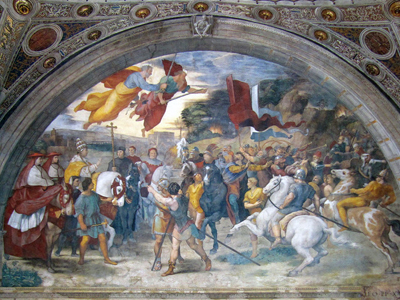 |
| Raphael Stanze, The Attila Halt - click to enlarge |
Leo the Great in the fresco, with Leo X's face, undergoes Attila to halt his advance. Leone X appears twice, first as cardinal and the second as Pope. The explanation is that in 1513 Pope Julius II died and was succeeded by Leo X, obviously when Raphael began the fresco Julius II was still alive, while the future Leo X was a cardinal, meanwhile he died, so that Leo X appears in two different roles.
The fresco is divided into two parts, where is Attila and the Huns it dominates a convulsive drama, emphasized by lighting effects, while on the left side where advances the Pope, with divine protection, serenity reigns.
Julius II died in 1513, his successor Giovanni de' Medici, son of Lorenzo the Magnificent, took the name of Leo X, humanist and lover of the arts the young pope, when he was elected was only 37, in 1514 to the death of Donato Bramante named Raphael first architect of the “Fabbrica” (=construction) of the new St. Peter basilica, moreover entrusting him the task of "custody and recording of ancient marbles", a position thanks to which many ancient sculptures were saved and brought to the Vatican in the courtyard of the Belvedere.
Leo X in addition to these assignments, commissioned Raphael the decoration of the room known as the “Stanza of the Fire”, in this environment Raphael kept the vault which was frescoed by his former master Perugino.
To be able to support so many tasks, to which were added the pressing demands of patrons as Agostino Chigi "the Magnificent", Raphael prepared with great care drawings and cartoons for the frescoes which were then painted by the workshop and finished by himself.
In the Fire Stanza it is assumed to have worked Giulio Romano, Perin del Vaga, Giovanni da Udine and Giovanni Francesco Penni. The first wall to be painted in 1514 is the one that gives name to the Stanza.
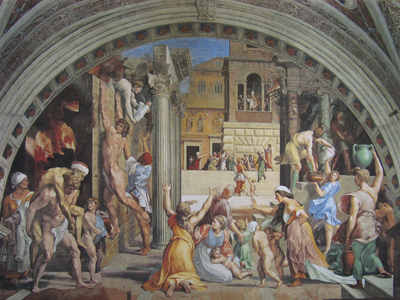 |
| Raphael Stanze, Fire Stanza - click to enlarge |
At the center in the background you see Leo IV, with Leo X face, who with his blessing miraculously extinguishes the fire that was about to destroy the Vatican district. To the left is depicted Aeneas with Anchises on his shoulders and beside his son Ascanio.
The fresco has been criticized for its asymmetry and forced metaphors. The Pope that extinguishes the fire symbolizes the peacemaking activities of Leo X, while Aeneas underlines the Pope's love for Virgil, all in a muscular context unusual in Raphael.
The Battle of Ostia was completed in 1515.
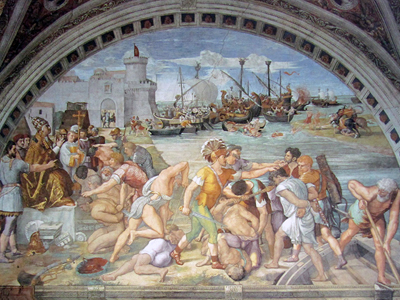 |
| Raphael Stanze, The Battle of Ostia - click to enlarge |
Here is commemorated the intervention of Leo III, who according to tradition, not very true to the history, defeated the Saracens at Ostia (Roma’s harbour). In this fresco the intervention of the shop has been greater than in the previous one, although the designs are always by Raphael.
Particularly to Giulio Romano are attributed the figures in the foreground and to Giovanni da Udine architectures and ships, while to the hand of Raphael we owe the portraits of the Pope and two cardinals. The one in the foreground is Giulio de' Medici, cousin of Leo X, the future Clement VII, the other is the powerful and deeply learned Cardinal Bibbiena, who Pope Leo X called Alter Pope, ie Pope in second. Portraits that once again reveal Raphael's ability to read the soul.
The Coronation of Charlemagne began in 1515 and was completed in 1516.
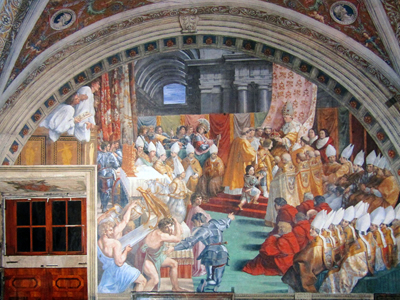 |
| Raphael Stanze, The Coronation of Charlemagne - click to enlarge |
Here is commemorated the famous event which took place in 800 when Leo III crowned Charlemagne in the ancient Vatican basilica, claiming to the Church the legitimacy of the imperial office. At the same time as the Pope's face is that of Leo X and that of Charlemagne is that of Francis I, King of France, it alludes to the agreement of Bologna of 1515, with which the Pope put an end to the conflict between the Roman Church and the kingdom of France.
In the episode of the coronation of Charlemagne, we can appreciate the inexhaustible creativity of Raphael, here he invents the live coverage, as seen watching the group of prelates, surprised in unorthodox attitudes, while the man with the armor urges the bearer.
The last wall to be painted is that of the Oath of Leo III, completed in 1517.
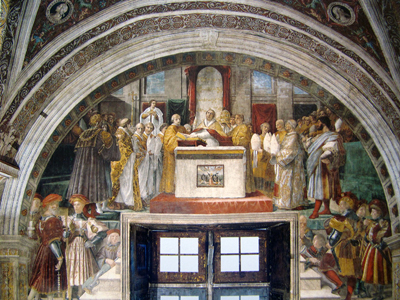 |
| Raphael Stanze, Oath of Leo III - click to enlarge |
The episode represented refers to the sentence pronounced by the Pope: “Dei non hominum est episcopos iudicare”, that is, the bishops can only be judged by God.
Since the Pope's face is always that of Leo X, the parallel is with the confirmation, which took place in 1516, of the bull of Boniface VIII, who in 1300 stated that only God can judge the head of the Church. Do not miss to the left the knights of Malta and the portrait of Lorenzo the Magnificent, father of Leo X.
To complete the decoration of the Pope's apartment, all that remained was an environment, the great hall named “Stanza of Constantine”, which Leo X commissioned Raphael to the end of 1517.
 |
| Raphael Stanze, Stanza of Constantine - click to enlarge |
Engaged in so many assignments, the heaviest of which was the design of the new basilica of San Peter in the Vatican, Raphael, also involved in the Loggia of Psyche at Villa Farnesina-Chigi, proceeded rather slowly, so that only in 1520, shortly before his death, he had completed the cartoons, so the Stanza of Constantine.
was painted entirely by his workshop, inherited by the great Giulio Romano, the most talented of Raphael's pupils, who at the time was 25 years old. As the workshop has followed the cartoons of the Master, in the quality of the paintings one can find a certain discontinuity.
However, many portraits are excellent, including the self-portrait of Giulio Romano and the portrait of Fugger, banker of Charles V.
Finally, in the fresco of the donation of Rome we see the apse of the ancient basilica of St. Peter, the so-called Constantinian basilica, preceded by the ciborium with spiral columns, a form revived by Bernini in his famous canopy. The Stanza was completed in 1524 when ruled Pope Clement VII de' Medici.
In conclusion, the Stanze are the essence of Renaissance culture, the manifestation of the involving genius of Raphael, the evidence of his insatiable curiosity and freedom of a mind always looking for new horizons.
back |

